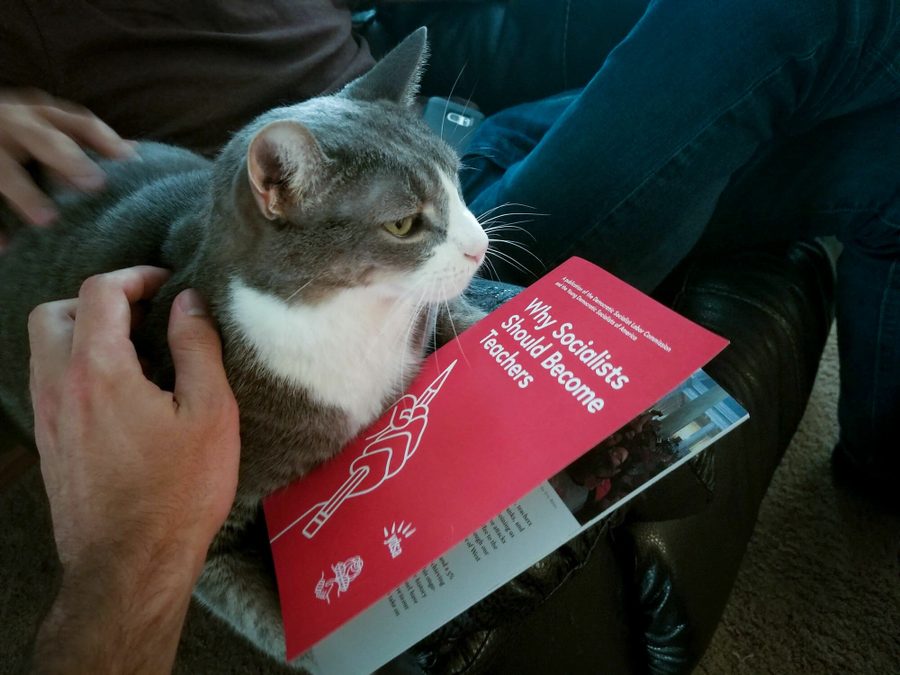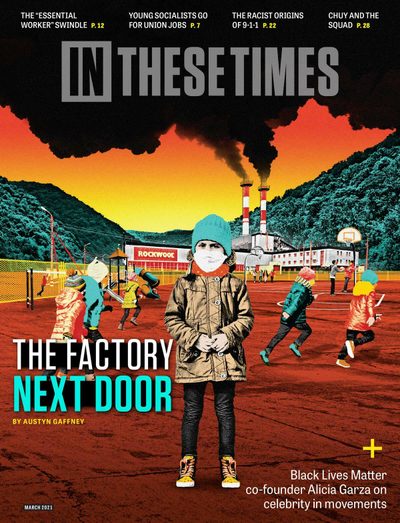The Young Socialists' School-to-Union Pipeline
Members of the Democratic Socialists of America are embracing the “rank and file strategy.”
Indigo Olivier

When West Virginia’s union teachers defied state law and walked off the job for fair wages and better healthcare in February 2018, their wildcat strike — and the wave of strikes it inspired — changed lives hundreds of miles away.
For example: Claire, a pre-med student at New York University (NYU), switched from the doctor-track to nursing — with the aim of landing a union nursing job. Claire is a member of NYU’s chapter of the Young Democratic Socialists of America (YDSA), which encourages members to find union work.
In These Times spoke with half a dozen YDSA and DSA members across the country about their similar plans. (Claire and others requested pseudonyms to avoid limiting their chances of employment.) All of them pointed to the militant example set by teachers as a motivator.
Emily, 22, a YDSA member in New York who wants to become a teacher, says the West Virginia strike was “probably the most inspirational thing I’ve seen in my years as a socialist.”
In 2018, YDSA committed to steering college graduates toward unions to build working-class power from the shop floor up. It passed a resolution to create a National Labor Committee (NLC) in the summer of 2020, which will oversee a school-to-union pipeline and administer a yearly survey to assess union interest after graduation, among other responsibilities.
The strategy dates back to at least the 1970s, when socialist organizations asked members to “turn to industry” and take up blue-collar jobs. The International Socialists went a step further; they advocated a “rank-and-file strategy” to place committed organizers into auto plants, steel mills and other factories, to inspire a “militant minority” of union membership to transform the working class into an agent of political change.
While YDSA has only just begun implementing its rank-and-file strategy, the New York City chapter of the Democratic Socialists of America (NYC-DSA) passed a similar resolution in the summer of 2018. Articles in Politico and the New York Times went on to condemn what they deemed a socialist infiltration of New York City’s most powerful unions.
Labor organizers within NYC-DSA, however, take issue with this characterization. They say they are building strong, democratic unions by focusing on day-to-day issues (such as overtime and health and safety), not pursuing union staff positions. NYC-DSA did not provide an estimate of how many members have taken union jobs, but the chapter’s Labor Branch says a large number are working in a range of union industries (from blue-collar to professional) and in a range of rank-and-file roles (from shop steward to low-level union officer).
When shop floor issues arise, these DSA members offer to bring their coworkers to a Labor Branch meeting for training — on how to find a committee of people to run a campaign, for example, or how to turn a grievance filing into a collective action.
Their idea is to fight collectively to improve working conditions and to demonstrate to other workers that solidarity is a winning strategy — one that can eventually expand to the whole working class.
Others are more skeptical. “This idea that socialists should switch jobs, get whatever certification is necessary and go into these strategic sectors [is] really not something that most of our members can do,” says Ryan Mosgrove, secretary of Metro D.C. DSA and an organizer with a local teachers’ union. “Many of our members are in low-wage work. Many of them are not in these urban, high-union-density, metropolitan areas where this sort of strategy is even applicable.”
Mosgrove says that, as only 1 in 10 U.S. jobs is a union job, members should organize whatever workplace they happen to be in.
Proponents of the rank-and-file strategy — like Barry Eidlin, a sociology professor at McGill University—argue that militant minorities have historically played a critical role in working-class victories. They are “the necessary building block for any kind of mass collective action,” Eidlin says. “It’s a marathon, not a sprint. Even if you get a few people going into various types of unionized jobs (as opposed to becoming [a nonprofit] worker), that can really shift things.”
YDSA’s focus on only a few particular sectors — healthcare, education and logistics — is also controversial. YDSA believes these sectors can have the most impact for the working class because of their preexisting labor militancy, a higher than average unionization rate and (especially in the case of logistics) the structural leverage they hold within capitalism. Eidlin believes that inroads into manufacturing and production will also be essential to any long-term strategy.
The success of this rank-and-file strategy will be difficult to measure, especially because of the time it takes to build trust with coworkers or transform entrenched union bureaucracies. Proponents believe that socialists should be prepared to make a lifelong commitment to their organizing.
Adam, 23, a YDSA member in Florida who is studying to become a union teacher, is ready to take the leap. “There are no shortcuts to organizing,” he says.
Indigo Olivier is a reporter-researcher for The New Republic and a 2020-2021 Leonard C. Goodman investigative reporting fellow. Her writing on politics, labor and higher education has appeared in the Guardian, The Nation and Jacobin, among other outlets.









